
The war in Ukraine and the end of everything
The renovations and restoration of Mariupol’s “City Palace of Culture” – located in the working class Livoberezhnyi District (or Left Bank) of the city – were completed in 2020. It was part of Mayor Vadym Boichenko’s plan to build a culture center for each district of Mariupol. First constructed in 1952, City Palace of Culture housed over 21 arts organizations serving roughly 800 adults and children weekly. One of the last public events held there in January 2022, was an arts festival for children and the disabled (see video below) funded by the United States Agency for International Development (USAID); hardly a radical or threatening organization.
City Palace of Culture was one of several arts institutions and arts schools where Mariupol residents sought refuge after the Russian invasion of Ukraine began on February 24 earlier this year. Another institution was the (now destroyed) Donetsk Regional Drama Theatre where 300+ civilians were reportedly killed in an airstrike on March 16. In a recent Associated Press news story (see link below), Mariupol resident Marina Galla, and her 13-year-old son, describe how they lived in the Palace basement for three weeks drinking only melted snow. You can see where City Palace of Culture is located in the aerial drone shot of Mariupol (pictured above) – on the upper left corner near the trees, just under the massive plumes of smoke.
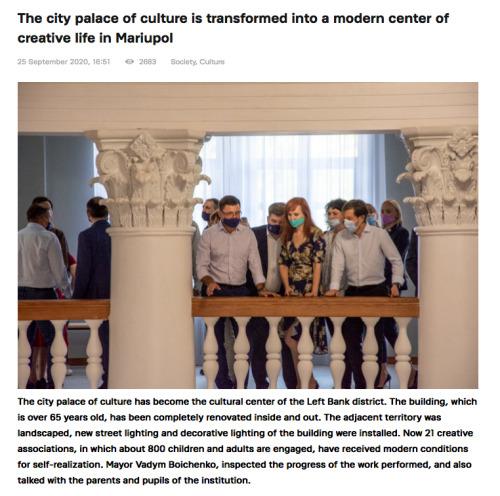
Screenshot of news article on Mariupol city government website on September 25, 2020.
There were no “great” artists working at City Palace of Culture. I doubt there was an experimental media art division, or any artists-in-residence on site to “queer the archive” from previous decades. There does not appear to be an exhibition history sub-titled with grant-speak phrases employing “placeholder” code words learned in MFA programs. No arts groups from City Palace of Culture will ever be programmed at kunstenfestivaldesarts or Theatrefestival Spielart or BAM Harvey. I doubt artists working there aspired to get a PhD in New York or Helsinki, or pursue a course of study at P.A.R.T.S. and DasArts – if they even knew such places existed. There were no artists in possession of a resume working at City Palace of Culture who might be deemed worthy of saving by Artists At Risk or their partner organizations throughout Europe.
The goal of this Mariupol institution was to serve the cultural needs and wishes of the community where it was situated; which translates into the possibility that more community-oriented arts groups, or folk arts groups, would be in residence there. This likely would not align with the tastes and trends preferred by the reigning “curator class” that constitutes review panels at MAPFund or Creative Capital. City Palace of Culture was a public institution supported with public funding in Ukraine; similar to cultuurcentrums in Flanders, or kulturhusets in Sweden. City Palace of Culture was an arts center where working class Mariupol residents “can realize themselves” (Mayor Boichenko). A place where parents would take their kids for dance classes and art classes – or the chance for toddlers to meet Olaf from FROZEN over the Christmas holidays.
The destruction of Mariupol and the genocidal tactics inflicted upon residents in the Livoberezhnyi district – has nothing to do with Vladimir Putin’s fears over NATO expansion, or US-run biological labs in Ukraine. These apologist excuses are just plain bullshit.
The butchering of families and children seen in the highlight video above – is a direct result of the actions of Russian-backed separatist thugs and criminals; who once upon a time had no problem shooting down a civilian airliner loaded with Australian, Dutch, and Malaysian families. The Russian soldiers, paramilitaries, and Chechen mercenaries laying siege to Mariupol this month, keenly appropriate “ethnic cleansing” tactics once perfected in the 1990s by Bosnian Serbs and the regime of ex-Serbian President (and war criminal) Slobodan Milošević. The West has seen this program broadcast before on our TV screens with the Siege of Sarajevo, the massacre of 5,000 men and boys in Srebrenica, and war crimes in Kosovo. We have allowed this grand repetition to unfold in broad daylight, like some re-run episode of SEINFELD or MELROSE PLACE. The only difference is today we view the horror via compressed clips on consolidated software formats, conveniently delivered by algorithms operating on devices we carry with us in our pockets.
- - - - -
Back when I was a kid in New York, I distinctly recall when the first President Bush proclaimed the ushering in of a “new world order” with the fall of the Berlin Wall and collapse of the Soviet Union. Bush was correct; just not in the way he envisioned. The preview trailer first offered via the Tiananmen Square Massacre was followed by a Litany of Sequels – the slaughtering of Iraqi Kurds and Shia; the Bosnian War and Srebrenica; the Rwandan genocide; mass incarceration across the United States; the growth of the Exponential Slave Trade across Bangladesh and South Asia; the genocide in Darfur; the Second Intifada in Palestine; the Iraqi diaspora and Yazidi genocide; abandoning millions of Afghan women and girls to Taliban rule; the Uyghur genocide in China; the never-ending international refugee crisis; the civil war and famine in Yemen; the civil war and famine in the Tigray. Each year, the distance of space and time between each event compresses; until it all just blends and bleeds into a neatly consolidated News Feed stream. Does anyone even recall that infamous political cartoon meme of blue Facebook Thumb-Likes delivered as international aid to besieged Syrians in Aleppo? The world’s first “genocide via social media” is now more than five years old – with Myanamar’s military initiating the Rohingya genocide and ethnic cleansing of Muslims by manipulating Facebook, Twitter, and YouTube with “fake news” posts and “deep fake” videos; often with Facebook’s full knowledge and the collective complicity of our own user agreements (see PBS FRONTLINE).
There is a little-known play by the late Serbian-American writer, Steve Tesich, called ON THE OPEN ROAD. The play is set in the aftermath of a civil war. It ends with the main characters, two thieves, slowing dying on the cross after they are crucified. One thief says to the other thief: “That’s the problem. We get it. People bleed before our eyes, but in the midst of their agonies – we get it. The problem is not that we’re blind or deaf to their cries, the problem is we get it and move on. Wars break out? We get it. Peace comes? We get it. Wars break out again? Once again, we get it. We’re always one step ahead of the game. There’s only one god left. The I Get It God.”
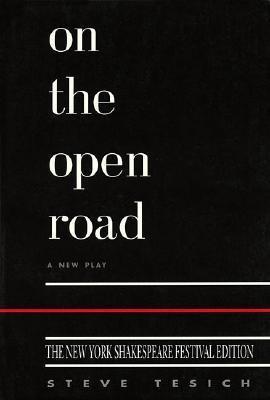
Cover to ON THE OPEN ROAD by Steve Tesich. Applause Books, 2000.
The “I Get It God” is a supreme deity; one whose rule and judgments are absolute. The “I Get It God” wields greater power than Putin’s censorship crackdown in Russia; or far-right and far-left conspiracy theories in the American blogosphere. The “I Get It God” has been revealed as the one and only true God, whom we all worship in our contemporary reality; even agnostics and atheists have willfully converted into true believers.
Nietzsche was mistaken. For the entire length of the 20th century, God was not dead; merely sleeping. The “I Get It God” has now awakened. We all collectively shudder at the prospect of feeling His (or Her) wrath. We tremble at the altar of the “I Get It God”. We hope our offerings will prevent our nations, our cities, our neighborhoods, our arts centers, and our families from becoming participants in the genocides, the wars, the famines, the pandemics, and the financial meltdowns we glimpse on our screens as we scroll through our News Feeds; comfortable on our side of the aluminosilicate glass which constitutes the liquid crystal displays in our smart-phones and tablets. We fervently pray that the screens will hold.
On the other side of the glass – exists the amassed victims from all the accumulated horrors we have watched unfold on Repeat Mode. The victims on the other side of our liquid crystal displays offer up their own desperate lamentations to the “I Get It God” – pleading for mercy to be released from their sufferings. They beg for blessings to be issued from on high. They await permission to step through the glass and join us here on the other side – stepping into a magical land of backyards, IKEA, food selfies, AirBnB, student loans, 401k plans, and the privilege of arguing over our preferred pronouns.
But the Lamenters’ prayers are left unanswered; discarded by the “I Get It God”who clearly has better things on the menu. The dispossessed and the desperate have no choice but to take several steps back from the glass – look away from “The Advertised Life” perceived through their displays – and resume their slavish, brutish work toiling away on the farms and in the factories which produce our strawberries and avocados, our opioids and cocaine, our iPhones and portable bluetooth speakers. If they are lucky enough to survive the litany of genocidal sequels listed above – and somehow live through the transition from conflict zone into newly flattened earth; where prefabricated structures are erected over the bombed-out ruins – there may appear a slim chance at having a decent life. After all, there will always remain new Walmarts, new Amazon distribution hubs, and new H&M factories to build. There will always be new pipelines and off-shore drilling facilities to construct in remote locations removed from our immediate view. Maybe one day in the distant future, if the Lamenters are lucky – the “I Get It God” will remember where the amassed victims were placed – and the “I Get It God” will approve a single grant application to allow someone to step through the glass and offer the Lamenters a temporary voice. Maybe, if they behave like good subjects – they will get a podcast episode. Maybe, if they are truly blessed – someone will produce a NetFlix documentary about them.
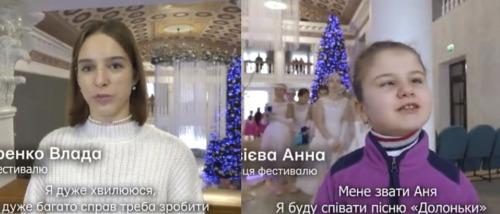
Screenshots of Vlada Zolotorenko and Anna Terzieva taken from Mariupol promo video (late-January 2022), with Ukrainian and Russian language subtitles.
Vlada Zolotorenko and Anna Terzieva.
These are their names. Vlada and Anna are the names of the two young girls from Mariupol who were interviewed in the highlight video (see above) from one of the last events ever held at the City Palace of Culture during January 2022. Both were participants in the “Together We Are One!” arts festival that was funded by the USAID. Vlada is the young girl seen wearing angel wings, while she sings into a microphone. Anna is the young disabled girl – most likely blind, or partially-blind (based on her eyes and head posture) – who was so happy to report to the interviewer that she was going to sing the song “Palms” that night. When Vlada was interviewed on camera, she was “very worried because a lot of things need to be done” still to prepare for her performance at the festival. A Christmas tree lit with blue lights stands behind the girls when interviewed in the main entrance hall. It is the same location Mayor Boichenko toured when City Palace of Culture opened two years earlier. The Mayor is photographed in the same main entrance hall with high gilded ceilings for the feature article that – as of my writing this in March 2022 – still appears on the City of Mariupol’s official website. It is likely that Mariupol’s municipal website will need to be taken down soon. Mariupol no longer exists.
But the fact that Vlada and Anna were performing at City Palace of Culture in January 2022 – singing their chosen songs that each young girl had probably rehearsed for hours and hours after school for weeks – is proof that Mayor Boinchenko’s vision was being realized for a thriving arts center that served the cultural needs of working class residents in the Livoberezhnyi District. By all accounts – from reading comments on Facebook and Instagram from Mariupol parents, friends, and other participants (all converted from Ukrainian and Russian via Google Translate) – it seems like Vlada and Anna had a wonderful time. Each young girl must have felt incredible after they sang – empowered, as if anything was possible – after performing in such a modern, professionally-equipped cultural center. Vlada, Anna, and all the other children and disabled Mariupol residents seized the opportunity to realize themselves.
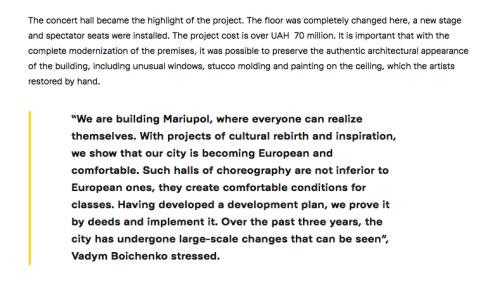
Screenshot of news article on Mariupol city government website on September 25, 2020.
Where are Vlada Zolotorenko and Anna Terzieva now?
Are they injured?
Are they even alive?
How is it that we do not know the answers? Why are we not even asking the questions? Who among us is responsible for keeping track of such things?
Did these two young girls make it out of Mariupol with their respective families to the relative safety of Western Ukraine? Were they forced by Russian soldiers or Chechen mercenaries to board chartered buses which took them to camps that satellite imagery reveals have been constructed deep in Russian-controlled territory? Are Vlada and Anna still stuck inside Mariupol? Are they alone? Are their parents dead? Are the girls with their grandparents? Are they entering their fourth or fifth week of drinking melted snow? Is there even any more show left on the ground?
Or are Vlada and Anna dead already?
Are both girls buried beneath the ruins of Donetsk Regional Drama Theatre? Or does each young girl lay dead buried beneath a different arts center or a different arts school; one of dozens reportedly destroyed by Russian artillery this month? What happened to the angel wings Vlada made for her performance? Was she happy and proud at how her wings turned out? In the rush to escape her apartment, did Vlada forgot to take her wings with her down into the bomb shelter? Did she sing down there in the darkness to pass the time? And if young Anna is partially blind – what must this entire experience have been like for her? I don’t possess the ability as a writer to pose any more rhetorical questions about Anna. I can only think about the joy she expressed on her face in her interview. I cannot conceive of the world Anna has perceived during the last month with her four remaining senses. I have no descriptive words possible to conjure up the sentences to fit such visions.
In the place of sentences, there is only shame.
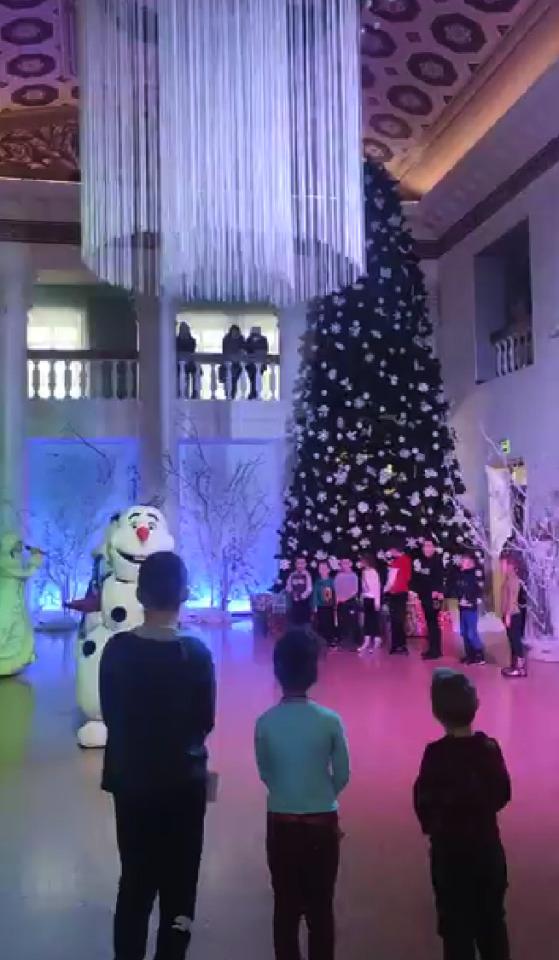
Enlarged screenshot taken from City Palace of Culture's Instagram account dating from late-December 2021.
The post-World War II era was supposed to prevent such atrocities from happening to young girls like Vlada and Anna. I recognize this ideal was never truly realized, but it remains the clearly stated goals at the time. The international community collectively swore “never again!” – coming together to form the United Nations in reaction to World War II and the Holocaust, as we all read transcripts from the Nuremberg Trials. The promise did not last long. Out of the five founding members on the U.N. Security Council – all five broke their promises rather quickly. The United Kingdom massacred Indians and Pakistanis, as it clung on to the vestiges of its empire. Russia covered up the Holodomor in Ukraine and it’s murderous mass deportations to Siberia from literally every satellite country behind the Iron Curtain. China erased Tibet from the map for all time, before turning its violent focus upon its own citizens in the Cultural Revolution. France brutally tried to hold on to its colonies in North Africa and Indochina. The United States took over from the French in Vietnam and then – well, pretty much acted like Americans always do everywhere else in the world with impunity. If anything once remained of the founding U.N. edifice that might be left to stand upon – that foundation turned to dust once Dutch officers toasted drinks with General Ratko Mladić on the night before he commenced his evil handiwork in Srebrenica – and the winds blew away any remaining embers once U.N. peacekeepers were not sent to help reinforce Commander Dallaire’s UNAMIR mission in Rwanda.
I no longer understand the arts. I foolishly thought this sense of immediacy and commitment to reaching everyone in real-time was supposed to be our ultimate goal. Sadly, it is far from the truth.
Along the way – somewhat impossibly – a young Jewish girl’s diary was found in Amsterdam. She was a European citizen living in The Netherlands, who was killed by Germans during the Holocaust. Her hand-written words were all that remained of Anne Frank. After it was rejected by several publishers and editors, Anne Frank’s diary was eventually published in The Netherlands; then in England and New York. It has since been published in over 70 languages and is one of the most important works of the 20th Century; (at least, until the reigning “curator class” deems otherwise). Anne Frank was a few years older than Anna in Mariupol; but most likely, closer in age to Vlada. The two girls probably had a lot in common. Color me crazy, but I thought the reason we read Anne Frank’s diary in grammar school or secondary school – was that we would become informed and educated enough as adults to prevent the same thing from happening again. I thought that was the whole point. To learn. To evolve. And if called upon – to fight – fight in order to prevent history from repeating itself.
Instead – on the contrary – unknown and anonymous Anne Frank clones have been popping up everywhere for decades. They live in Palestine or in Ethiopia; in Yemen or in Bangladesh. Or they once lived in Rwanda or in Bosnia, in Syria or in Iraq – and either died there, or escaped at some point as refugees to grow into 20-somethings or 30-somethings living in Lyon or in Hamburg; in Malmö or in Turku – now with children of their own. I can’t recall if any of them have had their own diaries published. I recognize this is a serious problem; we have not yet heard their voices – when we should. I don’t know why Anne Frank retains her status as the singular example. Hell, there are probably several million young Afghan girls secretly writing diaries all over Afghanistan right now – desperately waiting for the Taliban to permit their return to school. What gets me the most is the repetition. I cannot comprehend how we can sit back and witness the same scenes unfolding – and not be willing to change our behavior.
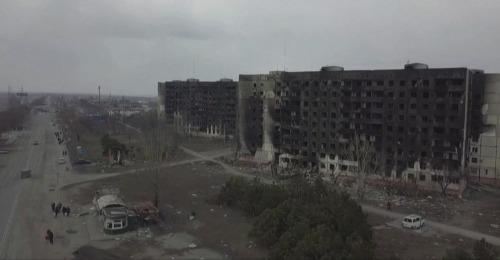
Aerial drone footage of Mariupol, dated late-March 2022.
In order to write this essay, I had to research the social media accounts of Mariupol Municipal Government and the City Palace of Culture. (Navigating Ukrainian-language news websites is hard work; it’s much easier to just do some digging across social media.) Each of their accounts remains frozen in time. Please view them for yourself here – @mariupolrada – and here – @livoberegniy . It appears no one has been able to access their Instagram since the Russian invasion began on February 24. I guess people either are dead or there is simply no time to “check-in” during a Russian siege. Imagine that. But each time I jumped back online to view the Mariupol social media accounts – to check my facts, or “Google Translate” more user comments – a curious thing happened. I would receive updates in my News Feed from all my friends and colleagues working in the arts and culture back home in New York, or across the European Union. And it was scary. The “I Get It God” was in full effect over His (or Her) entire dominion.
While I was writing an essay about the destruction of a publicly-funded arts center in Europe, the possible slaughter of two young Ukrainian girls, and the total leveling of a major city – this is what my friends and colleagues in the arts were focused on:
(1) A prominent Danish choreographer debuted a HD film examining her artistic practice. In excerpts shared online, she asks: “How do I know that my hands are my hands?” (as she gazes at her hands) – and – “I just want to understand more clearly what it means to be in a body.” These are both verbatim quotes. (2) A New York composer I admire (and with whom I have collaborated) shared a series of four photos he took with a Polaroid camera; an experiment in measuring rates of dissolving the exposure. The photos were selfies; they were photos of himself. (3) A Russian curator was posting her CV in the hopes of picking up some badly needed work, since (in her words) her “mortgage still needs to be paid.” (4) A New York arts foundation that has supported my work four or five times in my career, was announcing a new exhibition from a funded artist – the description for which I re-read three times. I still do not understand what the exhibition or the artist are about. (5) A major New York theatre was promoting an experimental reading series. The next scheduled play was “a text about text itself” that contributes to “developing a posthumanist approach” to contemporary theatre. I don’t know what this means, but it seems relevant; since our planet is hurtling towards an inevitable “posthumanist” moment, after our species commits self-induced extinction. (6)One of my best friends in Belgium, was promoting the upcoming release of his new album – by posting photos which superimpose his own head (and the heads of his bandmates) onto naked, de-gendered bodies – reminiscent of those old Ken & Barbie dolls. (7) A major British theatre, who nominated one of my plays for the biggest playwriting prize in the U.K., was promoting the last week of their production of – get this – a re-imagined adaptation of a Henryk Ibsen play, and titled it NORA: A DOLLS HOUSE. The description under the photo called it a “gripping, passionate and empowering, retelling” of Ibsen’s work. When they gave credit to the author of this adaptation – they misspelled the word “written” and instead wrote “wtitten”. Several days later, the misspelling was still there – wtitten.
What struck me the most about the New York scene, was an inherent sense of immediacy that did not sacrifice a commitment to high standards.
Their sole focus was only upon themselves. It was as if a major international conflict that could bring on World War III did not exist. There was not a single mention of the Russian invasion of Ukraine on Instagram; or the destruction of Mariupol – a city with a pre-war population of 446,000 people. Ironically, roughly the same population of nearby Stalingrad in 1942; when the actual Nazis began their siege. There was no mention of the Donetsk Regional Drama Theatre being bombed, or the assault on the Left Bank district where City Palace of Culture was located. It became painfully obvious there would never be any mention or awareness of these two young girls – Vlada Zolotorenko and Anna Terzieva – or any mention of their singing.
“Wtitten.”
“Wtitten.”
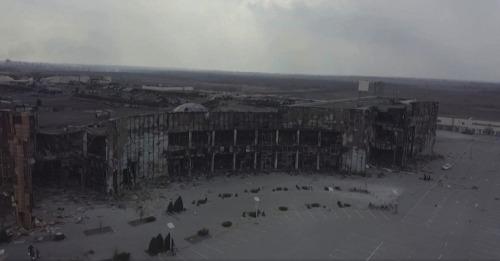
Aerial drone footage of Mariupol, dated late-March 2022.
I no longer understand my profession.
I do not comprehend the arts scene back home in New York. Nor can I decipher the cultural sector in the European Union. The horrors taking place right now across Ukraine can be reached by less than a 90-minute flight via Helsinki or Berlin. Our great detachment from the unspeakable traumas raining down upon girls like Vlada and Anna, are simply too identical to the violence inflicted upon residents of Sarajevo in the 1990s – which itself is located less than a 90 minute flight from Rome or Zurich. It’s that simple. It’s that repetitive. It’s that predictable. We are that pathetic.
I no longer understand theatre. I grew up in New York during the height of the HIV/AIDS crisis in America. And while I do not personally know anyone who died of AIDS – the artists who tackled the crisis head on to incessantly critique an indifferent Reagan-Bush regime made a lasting impact. They prepared me well for an Era of The Second Bush and his illegal invasion of Iraq. What struck me the most about the New York scene, was an inherent sense of immediacy that did not sacrifice a commitment to high standards. These artists channelled a rigorous approach to experimentation, inventing new forms and structures to describe the horrors and contradictions embedded within their experience. Perhaps – the most important takeaway – was their willingness to try to reach people, reach audiences – not within the span and schedule of a two-year grant cycle – but in real-time during real life. And not just for a pre-existing audience of “curator class” insiders. The goal was to reach everyone – so that everyone would know what was really happening.
I am living proof that their approach worked. As a teenager, if I did not encounter the work of the late American artist, David Wojnarowicz – a few months before he died of AIDS – I doubt I would have become a writer at all. I can still hear the grim musicality in his reading of the poem – “when i put my hands on your body.” Wojnarowicz’s brilliant collection of essays - CLOSE TO THE KNIVES - literally woke me up to the realities of an America that this straight, Irish Catholic kid had only dimly perceived in the lyrics of U2 songs behind the comfortable curtains of my family’s home. The immediacy and rhythmic rage of Wojnarowicz’s writing took hold of me and has never relinquished its grasp. His presence even permeates the sentence structure embedded within this actual essay.
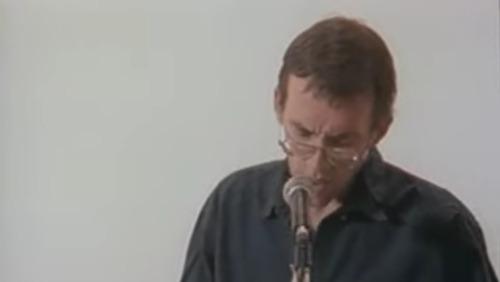
I never believed theatre could attain the sheer immediacy of David Wojnarowicz until I encountered the play – 11 SEPTEMBER 2001 by the French dramatist, Michel Vinaver. What this elderly man created after watching events transpire on his television in Paris – sitting half a world away from actual events unfolding in Lower Manhattan – represents the greatest artwork of the 21st Century. Period. Full stop. That Vinaver could invent a new dramatic structure – which could contain the entirety of 9/11 in a mere 40 pages – and that Vinaver completed this new play only a few weeks after the event transpired – represents such an achievement for the capacity and potential of the human species. I directed a reading of Vinaver’s play the following year in Manhattan. My own father – a 9/11 survivor himself – was in attendance. The revelations that unfolded amongst the audience that night was palpable. It demonstrated a way to circumvent precepts of the “I Get It God” – although it is probably due to His (or Her) [or Their] reign that you have never even heard of Vinaver’s dramatic text. The deity works in mysterious ways.
“Wtitten.”
“Wtitten.”
I no longer understand the arts. I foolishly thought this sense of immediacy and commitment to reaching everyone in real-time was supposed to be our ultimate goal. Sadly, it is far from the truth. The goal of theatre and contemporary arts is not to ring alarm bells to forewarn of approaching atrocities which might affect young girls like Vlada and Anna. Nor is the goal to create lasting documents in the girls’ memory, which might prevent the crimes committed against them from happening to others again in the future. No – on the contrary – the “I Get It God” has put an end to such aspirations. The goal of theatre and the arts under His (or Her) [or Their] reign must never be allowed to become anything more than a shallow exploration of rarified aesthetic questions tailored for an ultra-specialized, elite audience of the Pre-Approved. Under no circumstances shall we be permitted to gaze through our aluminosilicate screens and contemplate anyone or anything that might still exist on the other side. – [ We fervently pray that the glass will hold! ] – However, we have the option to switch on the Mirror App to better focus the tiny camera buried deep within the crystal. We always have the option to talk more about ourselves, elaborate upon our practice in artist statements, and “to understand more clearly what it means to be in” our bodies.
It does not matter if Vlada and Anna no longer inhabit their own bodies. They are not us. We have never met them. They have never seen our performances. They have no comprehension of our artistic practice. They do not agree with the precepts behind our work. They have never followed our profiles. They have never liked our photos. Therefore, they do not exist.
Under no circumstances, shall the Pre-Approved ever be permitted to feel too uncomfortable when they attend a work of the contemporary arts scene. Under no circumstances, shall the Pre-Approved be prevented from joining in “the great detachment” process of examining ourselves, expressing ourselves, or live-streaming ourselves. Under no circumstances, shall the Pre-Approved be transported via the contemporary arts “to learn something more, to breathe in something new, and then die someone else” – someone different than what they were before. The “I Get It God” now only permits two kinds of artistic work: (1) art that simply reinforces our pre-existing held beliefs – and – (2) complex artistic inquiries which employ a vocabulary so obtuse, so arcane that the artist might as well be a high priest conjuring up word-salad spells to hypnotize PhD candidates.
“Wtitten.”
“Wtitten.”
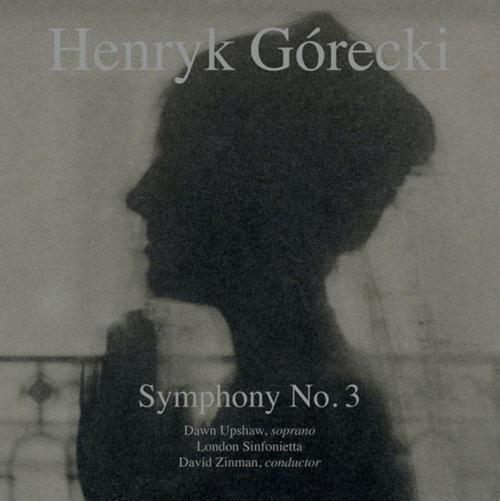
CD cover to “Symphony No. 3, Op. 36” by Henryk Górecki. 1992, Nonesuch Records.
Forty-seven years ago this week, will mark the first performance of “Symphony No. 3” by the late Polish composer, Henryk Górecki. The symphony in three movements clocks in at roughly fifty-four minutes. It is more commonly known as the Symphony of Sorrowful Songs, thanks to a documentary film by Tony Palmer about Górecki that was broadcast in 1993 on the BBC. “Symphony No. 3” explores the loss of a child to war, written from the perspective of grieving parents; still suffering, still searching in despair for the child who will never return. The symphony’s middle section, its second movement, consists only of a short message written by a teenage girl in Nazi-occupied Poland. Helena Błażusiakówna scrawled these words – “Mother, do not cry, no / Protect me always / Hail Mary” – onto the walls of her prison cell with shards of her broken teeth, after an interrogation by the Gestapo. Interviewed on camera years later, Górecki – who lost family members in concentration camps – struggled to explain why he wrote the Symphony of Sorrowful Songs. “The world today – it’s the same; also a nightmare, crushing us. Somehow, I had to take a stand; as a witness, and as a warning.”
The definitive 1991 recording of “Symphony No. 3” from the London Sinfonietta was played in full during Palmer’s film; interspersed by interviews with Górecki and archival footage from both World War II and conflicts raging around the world at that time (including Bosnia). The CD release on Nonesuch Records sold more than 700,000 copies within the first two years. It has since gone on to become the best-selling contemporary classical music album of all time. For a brief moment, it seemed possible the world was capable of heeding Górecki’s warning. We seemed willing and prepared to prevent the resurfacing of our past mistakes.
But the “I Get It God” was then awakened, perhaps sensing the hope we expressed. The “I Get It God” sauntered forth in the darkness, then rolled back the stone from where it had been encased, to step out of the chamber into the light. Our weak responses to the Litany of Sequels outlined above kept repeating and repeating with such frequency, the degree of horrors increasing so exponentially – that now most of us have chosen to “check out” and ignore the whole endeavor entirely. The current war in Ukraine should not come as a surprise; even if the scale and scope of Russian atrocities are startling. This is the natural and inevitable progression from our refusing to fight back and truly take a stand against even one of the Litany of Sequels that the “I Get It God” has deemed to propagate across the Earth.
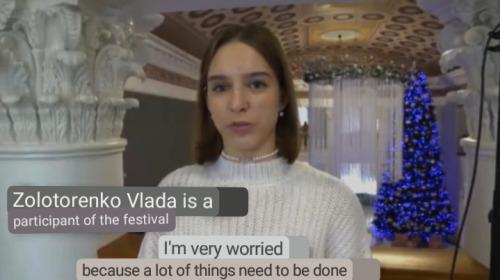
Screenshot of Vlada Zolotorenko with English subtitle translation.
Which brings us back to Vlada and Anna. What are we going to do?
The “Symphony of Sorrowful Songs” possesses two naturally occurring possibilities. Each option is inherent to the structure and composition of the music. We should take a moment to consider each option. How we choose to react will not only impact the fate of Vlada and Anna. It will determine whether we are capable of turning back the tide against the “I Get It God” – or if we only amount to becoming nothing more than spectators to the end of everything.
The first movement in Górecki’s “Symphony No. 3” is defined by a meandering series of mournful strings. These meanderings begin imperceptibly at first, before evolving in each repetition to assume a dominant, ominous tone. There are no words sung during the opening thirteen minutes. And yet the mournful strings seem to recount all the horrific Litanies of Prequels and Sequels across all the wars from human history. In the midst of this grim accounting – a lone voice of the soprano emerges – the voice of a mother searching for her lost child. The mother’s agony becomes the primary engine of the music; as she pleads for her dead child to speak. The power in the soprano’s voice makes one believe it might be possible. The soprano peaks at the 16:24 mark – before suddenly becoming subsumed by an even louder renewal of ominous strings. Wave after wave arrives, drowning out the soprano; who is lost for the remainder of the First Movement. The listener is left only with cycle after cycle of ominous strings; a droning recounting of all our Litanies.
This First Movement can be viewed as an analogy for how those of us working in the arts and culture have reacted to Vlada and Anna from Mariupol. The girls’ singing captured on the highlight video is moving for several moments; tragic for a few moments more, when taken into the context of a brutal Russian siege. There is a sense of dignity in tragedy; even hope, because of the catharsis induced in an audience. But as the ominous strings sweep in to drown out the singing of Vlada and Anna – hope vanishes – because without action these two girls’ voices will be submerged; lost for all time. The erasure of their Mariupol will continue. Eventually, the website of the former Mayor of this dead city will be taken down; along with all its social media accounts. The arts festival highlight clip will be erased from the internet. No one will ever think to look for Vlada and Anna. The girls will not be forgotten; they will simply remain unknown.
This is one path we can elect to follow.
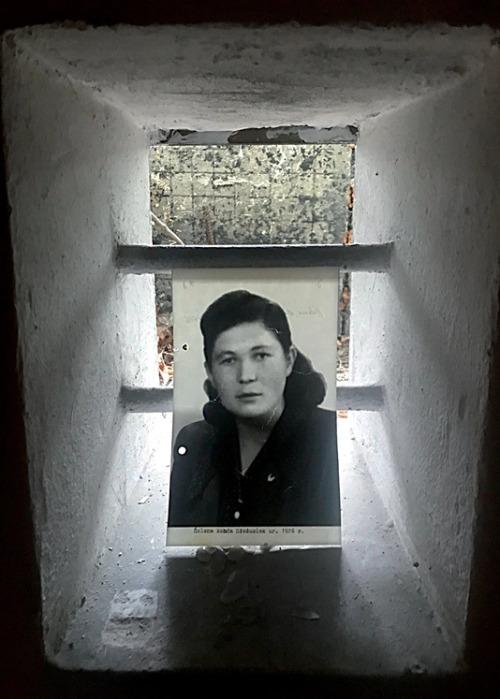
Photo of Helena Błażusiakówna installed inside the actual prison cell where she was detained and interrogated in Poland.
A second, more preferable option – and one that carries with it a degree of hope – involves us following the lyrics sung by the soprano in the Second Movement. These lyrics come from words written by an actual person – Helena Błażusiakówna – the teenage girl who scrawled a message to her mother onto the walls of her Gestapo prison. Helena was not killed by the Nazis; she survived. But it was not because of her own efforts; Helena was a severely beaten teenager. Helena survived because local partisans in the Polish mountains took a stand, fought back against the Nazis, and liberated Helena while she and other prisoners were being transferred. Helena was then smuggled across the Polish border, disguised as a Slovakian, and her injuries were tended to. After the war, Helena went on to marry and have a meaningful life; raising five children. Helena lived long enough to witness Górecki’s “Symphony No. 3” and hear the music he composed based upon his encounter with her words. Helena died in 1999, at the age of 73 – with the knowledge her words played a crucial role in a best-selling, beloved work of classical music.
Helena lived because of regular people. She lived because regular people decided to take action. Her Polish neighbors did not temporarily change their Profile Pic to the Ukrainian flag; nor did they merely employ variations of peace hash-tags. People took action; real action in the real world that carried real consequences. The local partisans who fought the Nazis, freed Helena, and smuggled her across the Slovakian border – did not stay safely within the confines of a placeholder frame on Instagram. They placed themselves at risk by taking action. They gave a beaten teenage girl the chance to heal; to grow into an adult and have a family. They ensured words Helena scrawled onto the walls of her cell, would be preserved – and not erased, to be lost for all time. Her words were found by Henryk Górecki. Her words bore witness to experiences countless others did not survive. Her words became an integral part of Górecki’s timeless warning.
This is another path we can elect to follow – a path of action.
I choose this second path; inspired by the words in Górecki’s Second Movement. It is the same path of action New York artists chose in the 1980s and 1990s; even while they were dying of AIDS. These artists experimented, they broke new ground, they combined or re-combined existing art movements into new structures, new containers, to channel the immediacy of their dire experience. Their goal was not to score a gig at Art Basel Miami; or secure a multi-year grant from the Kone Foundation to support indecipherable PhD research. The point was to reach people in real-time to create awareness and affect change. This second path is the one David Wojnarowicz repeatedly chose in his art, his performances, and his writings. This second path is the one Michel Vinaver chose in his play 11 SEPTEMBER 2001. Somehow, their choices made an impact upon me; playing an integral role in the artistic choices I make today. Vlada and Anna deserve the same chance to realize themselves. Based on their enthusiasm and commitment in the highlight video – who knows where their artistic lives could develop? Don’t those of us working in the arts and culture have the capacity now? To bear some responsibility now? To help them now? Are we capable of putting aside our pet-projects, our scheduled performances, our multi-year initiatives – and take action now?
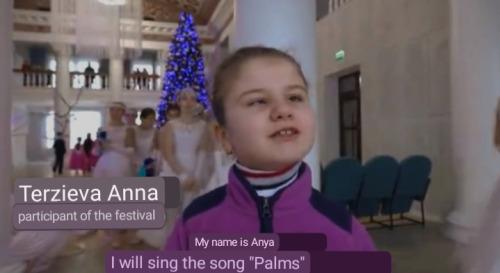
Screenshot of Anna Terzieva with English subtitle translation.
Górecki’s “Symphony of Sorrowful Songs” premièred at the Royan Festival in southwest France on April 4, 1977. Royan was a publicly-funded arts and music festival; one of dozens created throughout France in the post-WWII period. It was part of the decentralization movement to broaden the reach of arts and culture in France beyond just a few Paris-centric institutions. The legendary Festival d'Avignon was founded on the same principles; as were other festivals that sprung up around Europe like the Edinburgh Festival and the Holland Festival. A basic rationale was that Europeans had experienced enough war; Europeans had learned their lesson. There was a chance now to focus on the arts and culture, on science and education; it was time to provide citizens with the opportunity “to realize themselves” – as opposed to murdering each other on battlefields or in concentration camps.
Ironically, this is the same rationale Mayor Boichenko and Mariupol leaders expressed in their funding applications to the USAID. After living with war (or the threat of war) during the Crimea annexation and conflict in the Donbas regions – Mariupol’s leaders wanted to provide a better reality for its citizens. This is why the Livoberezhnyi District’s “City Palace of Culture” was renovated and retrofitted; under the same guiding principles that formed the Festival d'Avignon, the Holland Festival, or the kunstenfestivaldesarts. The musical performances given by Vladaand Anna during the (poorly-named) Together - We Are One! Festival will no doubt appear amateur to any card-carrying member of the “Curator Class” in Brussels. Their aesthetic value so beneath our own practice, the girls do not warrant a moment’s thought. However, the clearly-stated goals of Mayor Boichenko are so intrinsically linked to goals once stated by Jean Vilar, Rudolf Bing, or Frie Leysen – that we must recognize how deeply and profoundly we are all bound together.
Ukraine may not be a member of NATO, or any other military defense treaty that can assist Ukrainians. But the arts organizations in residence at “City Palace of Culture” – and the artists who performed on its stages – belong to a different union; one that should rally to their defense immediately. We should act now as if the Livoberezhnyi District housed the Théâtre des Bouffes du Nord, the Barbican, the Vooruit, or the Performing Garage. We should act now as if the Together We Are One! Festival in Mariupol was the aesthetic and moral equivalent of the Venice Biennale in Italy, the kunstenfestivaldesarts in Belgium, the Salzburg Festival in Austria, or any of the arts festivals on the verge of commencing in Europe this spring and summer and fall. At some point, we have to fight back – even at great risk to ourselves. At some point, we have to retake lost ground. We have to defend what has been built and avenge what has been lost. We need to build on what has come before. We cannot afford to ignore. We have to fight.
But if we decide our own artistic projects and programs are more important to focus on right now – if we choose to ignore Mariupol – if we decide the destruction of Donetsk Regional Drama Theatre and City Palace of Culture deserve a shorter shelf life for our attention spans than the Will Smith Oscars Slap – if we decide that Vlada and Anna are just two more young girls to be sacrificed at the altar of the “I Get It God” who has ruled over us for the last 30 years – then I have some very bad news for the Curator Class (and their colored, designer eyeglasses) …
We don’t get to do this anymore. Our time will be over.
No one will realize it at first. This conclusion will be dismissed by reigning members of the Curator Class. Things will go along this spring and summer and fall like it always does in the contemporary arts sector; just like it did after Srebrenica, after Rwanda, and after Aleppo. Things will look and sound the same on the surface, but at the molecular level – transformed into something different, something less, something worse, than what we were before. The actors performances we experience will feel meaningful. The programs we clasp in our seats to check under dim stage lighting, will feel palpable like the high quality paper we expected. We will marvel at the dancers’ complex movements and the orchestra’s technical skill. We will discuss at intermission how the unity of the set designer’s vision was not disrupted by the video designer’s editing choices. We will come back into the performance space to watch the Third Movement in anticipation of a moving dénouement; that so perfectly encapsulates what we were expecting when we first purchased our ticket weeks ago. The actors will return on stage, the music will swell, and the lighting cues will be called on schedule. It will reassure us – the rehearsed moments we are watching. But then – a crack will suddenly appear on the edges of the stage veneer – and a faint shrill will be discerned from the streets outside beyond the lobby.
And only then – when it is too late – will it dawn upon us that the performance we have been watching in the theatre is not what we believed. It has all been just a rehearsal for something else; something terrible and grand, with no antecedent to gauge its arrival. The mourning strings will grow louder as the final dénouement begins to subsume us. As the crack widens and the shrill grows louder, we only have a few seconds to live with the realization – that we have been reduced to passive observers – complicit and deranged – nothing more than spectators at the end of everything.
“Wtitten.”
“Wtitten.”
Further info and links (in English):
July 23, 2020. Mariupol municipal government press article.
September 20, 2020. Mariupol municipal government press article.
September 21, 2021. Mariupol municipal government press article.
October 1, 2021. Mariupol municipal government press article.
March 20, 2022. CNN feature article.
March 20, 2022. Huffington Post via The Associated Press.
March 26, 2022. inews.co.uk investigative feature article (behind subscriber paywall).
April 21, 2022. Press Conference b/w Mayor Boichenko & international press.
April 22, 2022. CNN interview w/ Mayor Boichenko.
April 28, 2022. CNN feature article on Mariupol, Ukraine.
Further info and links (in Ukrainian):
The official Mariupol municipal government website.
Mariupol municipal website portal for The City Palace of Culture.
ADDITIONAL VIEWING / READING:
1. “THE SYMPHONY OF SORROWFUL SONGS: GORECKI” - documentary by Tony Palmer (BBC) -
2. “SREBRENICA: A CRY FROM THE GRAVE” - documentary by Leslie Woodhead (BBC & Thirteen WNET) -
3. A PROBLEM FROM HELL by Samantha Power (2013) -
4. “when after all, it was you and me (or - the genocide play)” by Kevin Doyle -